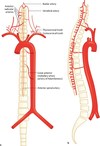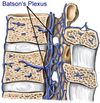Ch 1 Anatomy Flashcards
(253 cards)
Vermis of cerebellum is responsible for control of? hemispheres?
Axial = vermin
appendicular = hemispheres
AX the VERMIN!
Parts of cerebellum
Anterior Hemi
Posterior Hemi
Vermis
Flocculonodulus

Anterior Lobe gets input from?
Dorsal and ventral Spinothalamic Tract
Cuneocerebellar Tract
APe’S
Posterior Cerebellum is responsible for what function?
Precise movement
Flocculonodular Lobe is responsible for?
Equilibrium and Eye Movements
Way to remember old names of cerebellar lobes?
APeS FAVorite PreNuP
Ant = paleo or SPINAL cerebellum (ataxia)
Floc = Archi or VESTIBULOcerebellum (eyes and equilibrium)
Post = neo or PONTOcerebellum (precise mvmt)
Superior Middle and Inferior Cerebellar peduncles connect to?
Midbrain
Pons
Medulla
(makes sense)

Cerebellar Nuclei from lateral to medial?
Dentists Emulate Great Friends
Dentate
Emboliform
Globose
Fastigial

The dentate nucleus contributes to? What tract is it part of?
Dentatorubrothalamic tract which contributes to dexterity and synergy of movement.
What is in the dentatorubrothalamic pathway?
Purkinje cells -> dentate nucleus -> contralateral red nucleus -> ventral lateral thalamus -> motor cortex area 4,6

How does the dentate signals in the dentatorubrothalamic tract connect to the red nucleus?
Superior cerebellar peduncle
Fastigial nucleus contributes to ?
stance and walking
“stance and walking fast”
emboliform and globose nuclei are known as?
They contribute to?
Interposed nuclei
stability and speed in initiation of movement.
Lesions in the interposed nuclei cause?
TARDy
Titubation (makes sense cant keep the head steady)
Action tremor (cant move smoothly)
Rapid alternating movements off (cerebellum allows RAM)
DYsmetria (also makes sense)
Layers of the cerebellar cortex?
MPG
molecular
purkinje
granule cell layers
What cells are in molecular layer of the cerebellum?
Molecular
Basket cells
Stellate cells
Purkinje cell dendrites
Parallel fibers of granule cells
Golgi cell dendrites
Moleculer = miles of cells
What cells are in the Purkinje layer of the cerebellum?
just purkinje
Purkinje = Per
What cells are in the granular layer of the cerebellum?
Granule
Golgi
Glomeruli
Miles per GaLLon
Golgi cells make? role? acts upon what cells?
GABA
INHIB
GRANULE cells
Granule cells make? role? acts upon what cells?
Glutamate
Excitatory +++
Basket, Golgi, Stellate
ONLY GRANULE CELLS ARE EXCITATORY
Pukinje cells make? role? acts upon what cells?
GABA
INHIB
deep cerebellar nuclei and vestibular nuclei
Stellate cells make? role? acts upon what cells?
Taurine
inhib
Purkinje
Purkinje cells are inhibited by ? (2)
Basket cells (via GABA)
Stellate cells (via taurine)
Summary of Cerebellar cortex?
Only granule cells are excitatory
Stellate cells use taurine,
Basket, golgi and purkinje use GABA




















































